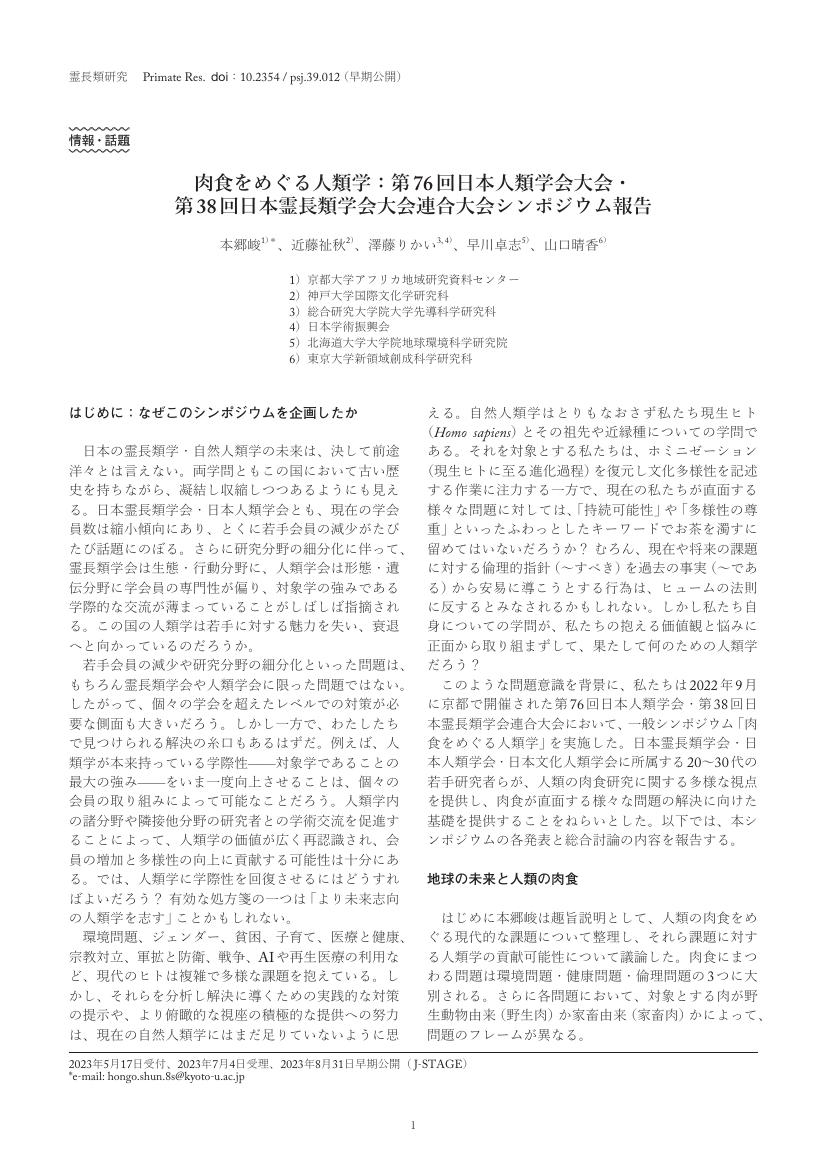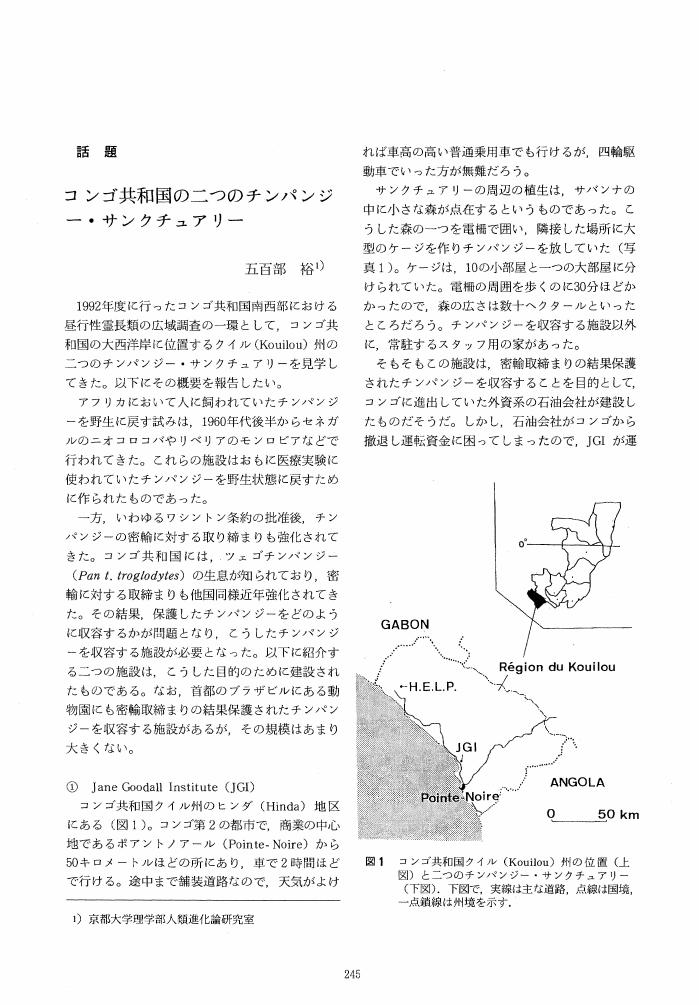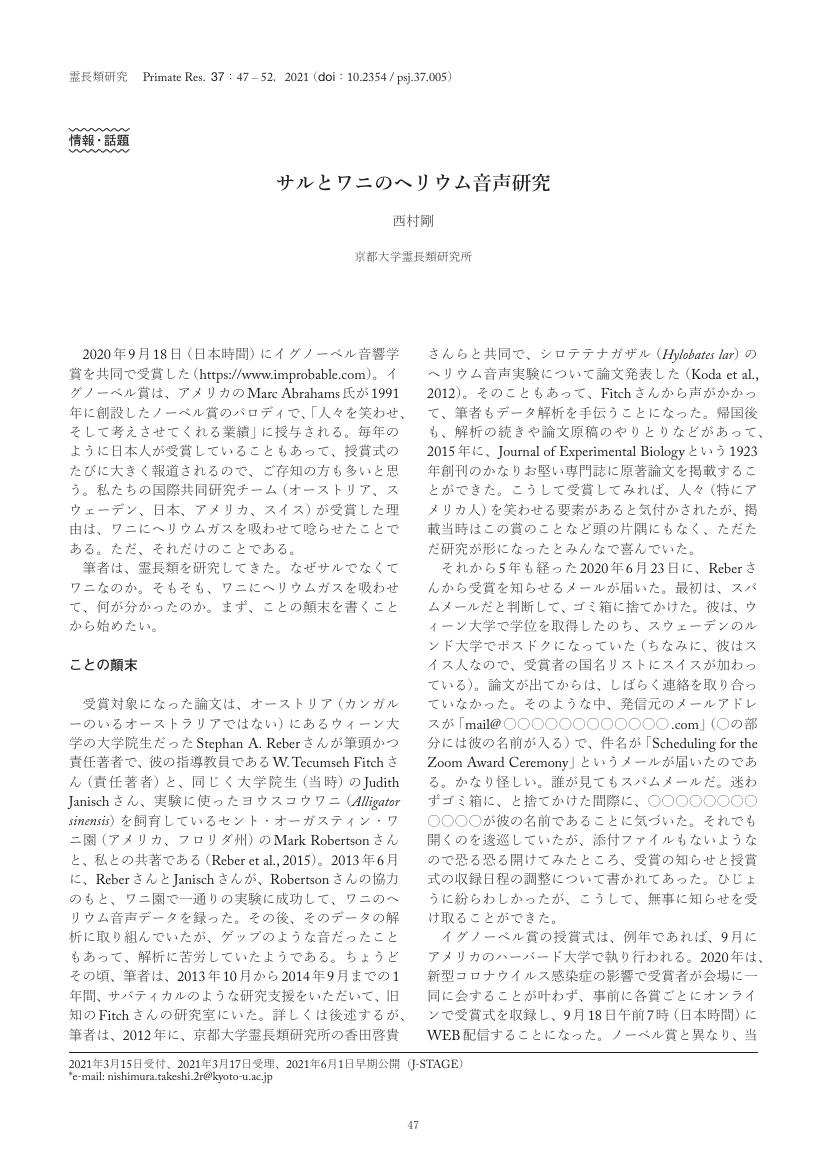2 0 0 0 OA ニホンザルにおける稀にしか見られない行動に関するアンケート調査結果報告
- 著者
- 中川 尚史 中道 正之 山田 一憲
- 出版者
- 一般社団法人 日本霊長類学会
- 雑誌
- 霊長類研究 (ISSN:09124047)
- 巻号頁・発行日
- vol.27, no.2, pp.111-125, 2011 (Released:2012-01-19)
- 参考文献数
- 29
- 被引用文献数
- 6 7
Questionnaire on infrequently-observed behaviors (IOBs) in Japanese macaques (Macaca fuscata) were given to primatologists. This survey aimed to provide basic information on the degree of rarity of each behavior. The questionnaire consisted of questions for respondents themselves, (e.g., name, research carrier, daily observation time), focal group (name of group and local population, captive, provisioned free-ranging, crop-raiding or purely wild), and IOBs. Experience of direct observation of 36 candidates of IOBs was also requested to answer by yes, no, or impossible to answer because of ambiguous memory or unawareness of its behavior. In total, 39 answer sheets were obtained from 32 respondents. The top 10 IOBs and the number of those answering "yes" in parenthesis are as follows: mating interruption by juveniles (1), simultaneously nursing different-aged offspring (1), tool-use (1), single mount ejaculation (2), transporting the older offspring (2), nursing the older offspring (2), simultaneously transporting different-aged offspring (3), pulling the hair of female chin as a courtship behavior by male (4), twin birth (4), and (diurnal) birth (6). Some of IOBs, such as mating interruption by juveniles, seem to be due to ambiguous memory or unawareness of its behavior. Apparent inter-population differences in the percentage of respondents answering "yes" to the all the respondents giving definite answers were found in some behaviors, such as embrace-rocking behaviors, mating behaviors in birth season, stone-handling, and feeding on vertebrates. Some of them, like the latter two, seem to have something to do with provisioning. With the modification of three categories by Nakamichi et al. (2009), we proposed the following five categories of IOBs: I) behaviors which are difficult to be observed despite its common occurrence; II) behaviors which rarely occur in every population: III) behaviors which rarely occur in some populations, but frequently occur in the others; IV) behaviors which are difficult to identify and memorize despite its common occurrence; V) behaviors which rarely occur during the most of the time but temporally occur.
2 0 0 0 OA チンパンジーの雄のみのグループ形成とその維持
- 著者
- 寺本 研 森 森裕介 長野 邦寿 早坂 郁夫 沓掛 展之 池田 功毅 長谷川 寿一
- 出版者
- 一般社団法人 日本霊長類学会
- 雑誌
- 霊長類研究 (ISSN:09124047)
- 巻号頁・発行日
- vol.23, no.1, pp.33-43, 2007 (Released:2009-01-01)
- 参考文献数
- 23
- 被引用文献数
- 6 6
Chimpanzees are a naturally highly sociable species. Therefore, it is desirable to keep captive individuals in a social group. Although the dyadic introduction method has been commonly used to form social groups, it has not always been successful. In the present study, we tested a new method to create three all-male groups, two of which consisted of .ve individuals, and one of nine individuals. This method requires three stages. First, male dyads were put into neighboring cages in which the individuals could see each other. Tentative social rank was determined by observing the males' behaviors in these dyadic encounters. Next, they were moved to an unfamiliar environment and housed individually. Several days later, they were introduced one by one to an outside enclosure. Three allmale groups have been maintained so far, suggesting that group formation was successful. The occurrence of severe injury was considerably lower than that seen commonly in multi-male multi-female groups. Moreover, signi.cant effects of the group formation on male behavior (e.g., increased number of active social behaviors and decreased abnormal behaviors) were observed. These results demonstrate the effectiveness of our new method of forming all-male chimpanzee groups.
2 0 0 0 OA チンパンジーの「文化」と社会性-「知識の伝達メタファー」再考
- 著者
- 西江 仁徳
- 出版者
- 一般社団法人 日本霊長類学会
- 雑誌
- 霊長類研究 (ISSN:09124047)
- 巻号頁・発行日
- vol.24, no.2, pp.73-90, 2008-12-20 (Released:2009-08-11)
- 参考文献数
- 45
- 被引用文献数
- 5 5
‘ The metaphor of transmission’ (cognition-transmission model), which is a root metaphor of contemporary primatology, was reconsidered and deconstructed by referring to other academic domains such as anthropology, communication study, psychology and cognitive science. Instead, I introduced another epistemological standpoint, action-practice model, based on the ‘ situated action’ approach, in order to expand the perspective of contemporary ‘ cultural primatology’ and to understand the relationship comprehensively between primate culture and sociality. From this standpoint, I analyzed social interactions along ant-fishing among wild chimpanzees at Mahale, Tanzania. Some situated characters of their social practice, such as attitude depending on others’ actions, moderate exploring proposition to others, and direct reaction to such propositions, were considered to be important to realize such social situation of ant-fishing as a cultural practice of chimpanzees.
1 0 0 0 OA 霊長類における離乳過程の種間比較: ヒトの「離乳時期の早期化」への洞察
- 著者
- 松本 卓也
- 出版者
- 一般社団法人 日本霊長類学会
- 雑誌
- 霊長類研究 (ISSN:09124047)
- 巻号頁・発行日
- pp.1, (Released:2023-12-19)
- 参考文献数
- 87
In this paper, I discuss the relationship between social organization and offspring-rearing methods, which are starting to be used as a novel indicator in interspecies societal comparisons. Additionally, I clarify the relationship between the intimacy of the mother–offspring relationship and the development of foraging in the offspring. I suggest that the establishment of a base camp in human evolution is important not only to facilitate effective hunting and gathering but also for immature individuals to reduce the cost of accompanying adults and engage in their own foraging activities.I also attempt to deconstruct weaning from the offspring’s perspective, which often focuses on the mother’s decision to stop breastfeeding. Specifically, I focus on the development of the offspring’s ability to acquire food independently and the offspring’s behavior away from its mother. I suggest that there is no significant difference between humans and African apes in the timing when the offspring significantly reduces its dependence on breast milk. This paper also depicts “early weaning” as a characteristic of the unique life history of humans, in which the mother conceives a second offspring at the same time as or even before the offspring becomes much less dependent on the mother’s milk.
- 著者
- 本郷 峻 近藤 祉秋 澤藤 りかい 早川 卓志 山口 晴香
- 出版者
- 一般社団法人 日本霊長類学会
- 雑誌
- 霊長類研究 (ISSN:09124047)
- 巻号頁・発行日
- pp.39.012, (Released:2023-08-31)
- 参考文献数
- 15
1 0 0 0 OA コンゴ共和国の二つのチンパンジー・サンクチュアリー
- 著者
- 五百部 裕
- 出版者
- 一般社団法人 日本霊長類学会
- 雑誌
- 霊長類研究 (ISSN:09124047)
- 巻号頁・発行日
- vol.9, no.3, pp.245-249, 1993 (Released:2009-09-07)
1 0 0 0 OA 霊長類学の発展に餌付けが果たした役割
- 著者
- 杉山 幸丸 渡邊 邦夫 栗田 博之 中道 正之
- 出版者
- 一般社団法人 日本霊長類学会
- 雑誌
- 霊長類研究 (ISSN:09124047)
- 巻号頁・発行日
- pp.29.011, (Released:2013-12-19)
- 参考文献数
- 120
- 被引用文献数
- 3 2
Primatology in Japan after the World War II began in the late 1940s with the observation of shy wild Japanese macaques (Macaca fuscata) from more than 100 m. Depending on artificial feeding students succeeded to observe macaques within a short distance and identified each individual. Individual identification of calm free-ranging macaques within a short distance made it possible to record individual and social behavior of each identified individual in detail; long-lasting kin-recognition between a mother and her offspring, dominance relations among individuals and kin-groups, and then, social organization. Artificial feeding is a form of semi-experimental manipulation introduced into the wild monkey groups. This paper showed how students contributed to the primate studies under such a condition at Koshima, Takasakiyama and Katsuyama. Some behaviors, particularly cultural ones, were found only in the artificially-fed groups. Some other exceptional or uncommon phenomena or behaviors seen in non-artificially-fed groups were recorded, with many episodes sufficient for statistical analysis at artificially-fed groups. As far as we are cautious that artificial feeding is semi-experimental manipulation on the wild monkey groups, we can find out more about the important nature of human and non-human primates and evolutionary relations of them.
- 著者
- 伴 和幸 江﨑 美貴子 川瀬 啓祐 冨澤 奏子 杉山 尚子 椎原 春一
- 出版者
- 一般社団法人 日本霊長類学会
- 雑誌
- 霊長類研究 (ISSN:09124047)
- 巻号頁・発行日
- vol.35, no.2, pp.73-79, 2019 (Released:2020-02-14)
- 参考文献数
- 24
Blood analysis is an important tool for health management. Our zoo succeeded in being the first in the world to train our mandrills (Mandrillus sphinx), to allow venipuncture using only behavioral restraint. Two mandrills at Omuta City Zoo participated in this project, one male (A) and one female (B). We used PVC pipe to create a sleeve that could be attached to the enclosure and set a bar inside of it so that the mandrill would grip it underhanded, thus presenting the inner side of the arm. By partially blocking the top half of the inside of the sleeve, the mandrills were guided to use an underhand grip. This simplified the training, with less stress for both animals and keepers. The needle insertion was done into the cephalic vein. We used sweet potato as the unlearned reinforcer and a dog whistle as the learned reinforcer. The process was as follows: 1) excitatory conditioning, 2) gripping, 3) gripping underhanded, 4) avascularization, 5) epilation, 6) needle insertion. Training was held once a day for an average of 6-11 minutes. Number of sessions and cumulative time were 34 sessions/365 minutes for the A and 65 sessions/392 minutes for the B. The training has retained a high success rate (85% for the A, 79% for the B), allowing for regular blood sampling.
1 0 0 0 OA マーモセット繁殖飼育簡易マニュアル
- 著者
- 三輪 美樹 鴻池 菜保 勝山 成美 中村 克樹
- 出版者
- 一般社団法人 日本霊長類学会
- 雑誌
- 霊長類研究 (ISSN:09124047)
- 巻号頁・発行日
- pp.38.018, (Released:2022-10-27)
- 参考文献数
- 48
Over the past two decades, a number of biomedical studies have been conducted in Japan using common marmosets (Callithrix jacchus). Common marmosets are highly promising experimental animals because of their high fertility, which is noteworthy among primates. Here, based on our breeding experience at Kyoto University, we have compiled a simplified manual that outlines how to breed and raise robust common marmosets, defined as those achieving over 350g in weight, in a captive environment. The manual covers selection of appropriate breeding individuals, effective pairing methods, perinatal management including birth control, feeding and housing management, and precautionary health status monitoring.
- 著者
- 大井 徹
- 出版者
- 一般社団法人 日本霊長類学会
- 雑誌
- 霊長類研究 (ISSN:09124047)
- 巻号頁・発行日
- pp.34.005, (Released:2018-06-27)
- 参考文献数
- 5
- 著者
- 落合 知美 綿貫 宏史朗 鵜殿 俊史 森村 成樹 平田 聡 友永 雅己 伊谷 原一 松沢 哲郎
- 出版者
- 一般社団法人 日本霊長類学会
- 雑誌
- 霊長類研究 (ISSN:09124047)
- 巻号頁・発行日
- pp.31.001, (Released:2015-03-20)
- 参考文献数
- 70
- 被引用文献数
- 2 2
The Great Ape Information Network has collated and archived information on captive chimpanzees within Japan since 2002. As of July 1st, 2014, a total of 323 chimpanzees were housed within 52 facilities across Japan, all registered in the Japanese Association of Zoos and Aquariums (JAZA) studbook. JAZA has recorded information on captive chimpanzees within Japan since the 1980s. However, for individuals unregistered and/or deceased prior to this period, JAZA holds scant information. There are very few surviving reports on living conditions and husbandry of such individuals, particularly for the years preceding the Second World War (WWII) (up to 1945). Here we present the first detailed history of captive chimpanzees in Japan before WWII, following a systematic investigation of disparate records. The first record of any live chimpanzee within Japan was a chimpanzee accompanying an Italian travelling circus in 1921. The history of resident captive chimpanzees in Japan began in 1927 when a chimpanzee, imported into Japan by a visitor, was exhibited in Osaka zoo. In the 1930s, many chimpanzee infants were imported to Japanese zoos until in 1941 imports were halted because of WWII. By the end of WWII, there was only one single chimpanzee still alive within Japan, “Bamboo”, housed in Nagoya. In 1951, importation of wild chimpanzees into Japan resumed. In total, we identified 28 individuals housed within Japan before 1945, none listed previously in the JAZA studbook. Of these 28 individuals: 6 entered Japan as pets and/or circus animals, 21 were imported to zoos, and one was stillborn in zoo. Of the 21 zoo-housed individuals, 7 died within one year and 9 of the remaining 14 were dead within 5 years of arriving in Japan. Four individuals are recorded to have lived 7-8 years. Only one male individual, the aforementioned “Bamboo”, lived notably longer, to about 14 years.
1 0 0 0 OA 日本の霊長類学小史:野生ニホンザル研究を中心に
- 著者
- 杉山 幸丸
- 出版者
- 一般社団法人 日本霊長類学会
- 雑誌
- 霊長類研究 (ISSN:09124047)
- 巻号頁・発行日
- vol.36, no.2, pp.41-55, 2020 (Released:2020-12-23)
- 参考文献数
- 135
- 被引用文献数
- 1 1
Modern primatology began in 1952-3 through artificial feeding of Japanese macaques at Koshima and Takasakiyama. Artificial feeding allowed short-distance observation, individual recognition and long-term observation. These new methods applied to wild monkeys made possible new findings, such as life-time kinship bonds, social organization, cultural behaviors, etc., which changed anthropology, biology, psychology and also other social sciences.During the 1st stage of the studies led by K Imanishi and J Itani, researchers focused their efforts not on biology but on sociology. Itani declared that Japanese primate studies do not reflect natural science. On the other hand, some other researchers carried out ecological studies of monkeys and proceeded on to socioecology. Itani attributed the dominance relations among individuals to the social order or hierarchy, whereas other researchers did so to competition over resources to increase reproductive success.In 1956 and in 1962, respectively, the Japan Monkey Centre and the Kyoto University Primate Research Institute were established. JMC contributed as the first organization of primatology in Japan, and KUPRI added to a confluence of field and experimental primatology. DNA fingerprinting to analyze the relatedness of individuals accelerated the unification of field and laboratory studies.After 1970, agricultural damage caused by wild monkeys exploded due to deforestation and the presence of unguarded crops. Researchers had to work to prevent such monkey activity in the field. They were also forced to cull this endemic primate species. As a result, the field of primatology had to expand in cognitive science, physiology, brain science and genetics as well as conservation activity.
1 0 0 0 OA 霊長類の乳児特徴とその認知の進化を探る
- 著者
- 川口 ゆり
- 出版者
- 一般社団法人 日本霊長類学会
- 雑誌
- 霊長類研究 (ISSN:09124047)
- 巻号頁・発行日
- vol.37, no.2, pp.145-153, 2021-12-03 (Released:2021-12-07)
- 参考文献数
- 60
Primates behave differently toward infants and adults and experimental studies have also confirmed that they visually differentiate between adults and infants. Infants have some visual characteristics that primates may potentially use as age cues. For example, infants in some species have special coat or skin colors that are different from adults. Such coloration is called “infantile coloration” and the extent of it varies across species. Although previous studies have suggested several possible functional roles of it, such as inducing alloparenting behavior, they still remain unclear. Contrary to such species-specific color features, infants also have morphological characteristics that exist across species. “Baby schema” is a set of infantile morphological features, such as bigger eyes, smaller nose and mouth, proposed by Konrad Lorenz. Baby schema is supposed to be shared with various species and works as a releaser of caretaking behavior. I reviewed the studies investigating the effects of infantile coloration and baby schema on behaviors and cognition. Although studies showed that humans show robust preference for baby schema, there has been so far no evidence suggesting that non-human primates are also sensitive to it. In contrast, there is some evidence indicating the importance of species-specific infantile features, such as infantile coloration, for non-human primates. Thus, it may be possible that preference for baby schema was specifically acquired by humans during evolution, while species-specific infantile features, like infantile coloration, are more relevant for non-human primates. Further investigation combining studies with different approaches, such as observational studies in the field, comparative cognitive studies in labs, and image analysis of various species, will help us to understand the evolution of infantile features of each primate species.
1 0 0 0 OA ニホンザルによる農作物被害問題とその研究の歴史的経緯
- 著者
- 小金澤 正昭 山端 直人 望月 翔太
- 出版者
- 一般社団法人 日本霊長類学会
- 雑誌
- 霊長類研究 (ISSN:09124047)
- 巻号頁・発行日
- vol.34, no.2, pp.149-152, 2018-12-20 (Released:2019-01-10)
- 参考文献数
- 20
- 被引用文献数
- 1
1 0 0 0 OA 高宕山自然動物園の再建に関する富津市への要望書提出
- 著者
- 藤田 志歩 河村 正二 山田 一憲 白井 啓
- 出版者
- 一般社団法人 日本霊長類学会
- 雑誌
- 霊長類研究 (ISSN:09124047)
- 巻号頁・発行日
- vol.36, no.1, pp.3-7, 2020-06-20 (Released:2020-07-14)
- 参考文献数
- 22
- 被引用文献数
- 1
1 0 0 0 OA ベトナム中部の自然保護区における霊長類の生態調査
- 著者
- 辻 大和 Nguyen Van Minh L.R. Ulibarri Nguyen Huu Van 濱田 穣
- 出版者
- 一般社団法人 日本霊長類学会
- 雑誌
- 霊長類研究 (ISSN:09124047)
- 巻号頁・発行日
- vol.28, no.1, pp.61, 2012-06-20 (Released:2012-10-21)
- 参考文献数
- 11
- 著者
- 森本 直記
- 出版者
- 一般社団法人 日本霊長類学会
- 雑誌
- 霊長類研究 (ISSN:09124047)
- 巻号頁・発行日
- vol.37, no.1, pp.128-129, 2021
1 0 0 0 OA 筋骨格形態と動作解析から探る霊長類体幹の機能学的解釈
- 著者
- 菊池 泰弘 小島 龍平 布施 裕子 木下 勇貴 岡 健司 藤野 健
- 出版者
- 一般社団法人 日本霊長類学会
- 雑誌
- 霊長類研究 (ISSN:09124047)
- 巻号頁・発行日
- pp.37.047, (Released:2021-11-16)
- 参考文献数
- 45
1 0 0 0 OA サルとワニのヘリウム音声研究
- 著者
- 西村 剛
- 出版者
- 一般社団法人 日本霊長類学会
- 雑誌
- 霊長類研究 (ISSN:09124047)
- 巻号頁・発行日
- pp.37.005, (Released:2021-06-01)
- 参考文献数
- 15
1 0 0 0 OA 大型類人猿を飼育する日本国内の組織について
- 著者
- 落合-大平 知美
- 出版者
- 一般社団法人 日本霊長類学会
- 雑誌
- 霊長類研究 (ISSN:09124047)
- 巻号頁・発行日
- vol.24, no.3, pp.405-411, 2009-03-31 (Released:2010-06-17)
- 参考文献数
- 14
- 被引用文献数
- 2 2





